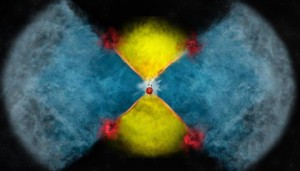Astronomers might have an explanation for why classical novae erupt in gamma rays.
A few months ago, researchers with NASA’s Fermi Gamma-ray Space Telescope reported that they’d detected gamma rays from several classical novae. These thermonuclear eruptions happen on the surfaces of white dwarfs that are guzzling too much gas off a companion star.

Bill Saxton / NRAO / AUI / NSF
The gamma rays baffled researchers: classical novae shouldn’t produce these high-energy photons. Gamma rays come from particles accelerated at shock fronts. That implies that stuff in the burst’s outflow is slamming into other stuff in the outflow. But there was no good explanation for why the ejecta would do that.
Radio observations of V959 Monocerotis, one of the Fermi novae, now suggest that it is differences in the white dwarf’s outflow that are to blame — but it’s not technically the white dwarf’s fault. Simply put, it’s because these stellar corpses are in binary systems.
To come to this conclusion, Laura Chomiuk (Michigan State University) and colleagues used several radio arrays to observe V959 Mon, starting about two weeks after the gamma-ray discovery. The signal they initially picked up matched not outflowing warm gas, but synchrotron radiation.
Synchrotron emission comes from particles accelerated to near-light speeds, just as gamma rays do. But radio emission lasts a lot longer, and it’s observable with much higher resolutions — a few dozen milliarcseconds in this case.
Observations spread over several months revealed something interesting. About four months in, the team detected knots of synchrotron emission, moving outward from the explosion. The outflow itself showed a clear bipolar shape, with its dumbbell pointing east-west. But 16 months later, the brightest region was still bipolar but pointing north-south. Essentially, it looked like the outflow pattern had rotated 90 degrees.
The white dwarf didn’t literally spin its ejecta. Here’s what probably happened:
When the white dwarf went nova, it first spewed out fairly thick, warm gas in a spherical shell around itself and its companion. As the gas flowed past the stellar companion, it formed a bow wave around the star, slowing the gas down in the orbital plane (but not in other directions). At the same time, the gas dragged on the star, stealing some of its orbital energy. The interaction forced much of the gas into a dense belt around the binary system. So when the white dwarf later blew out a fast wind, the thick stuff funneled that wind out along the poles. Shocks formed at the boundaries between the slower, thick outflow and the faster, thin outflow. These shocks gave birth to the outward-moving knots of synchrotron emission the team detected.
After the outburst turned off, the bright polar outflows floated away and dispersed. That left the slower-expanding, denser material, also in a roughly bipolar shape but perpendicular to the previous one.
The result is convincing, although Brian Metzger (Columbia) notes that, because the radio emission arises after the gamma rays, astronomers can’t be entirely sure that the same shock creates both, or, if it really is the same shock, that the shock’s properties are the same at both times. But concluding the same shock makes both types of emission is “economical.”
Although the observations are only for V959 Mon, the scenario likely works for the other classical novae, too. The main reason astronomers haven’t seen gamma rays from all novae is distance, says study coauthor Justin Linford (Michigan State University). At less than 6,500 light-years away, V959 Mon is fairly close; at twice the distance, it would have been too faint for Fermi to detect it.
To confirm this binary-spurred shock process also happens with other novae, astronomers will need to start multiwavelength observations as soon as possible after a discovery, says Pierre Jean (IRAP, France). Alerting astronomers to look in other wavelengths often takes several days, and keeping this delay as small as possible will help.
Reference: L. Chomiuk et al. “Binary orbits as the driver of gamma-ray emission and mass ejection in classical novae.” Nature.
Novae often repeat, sometimes appearing as variable stars in our sky. Explore the sky's variables with Sissy Haas's catalog Double Stars for Small Telescopes.
 0
0









Comments
You must be logged in to post a comment.